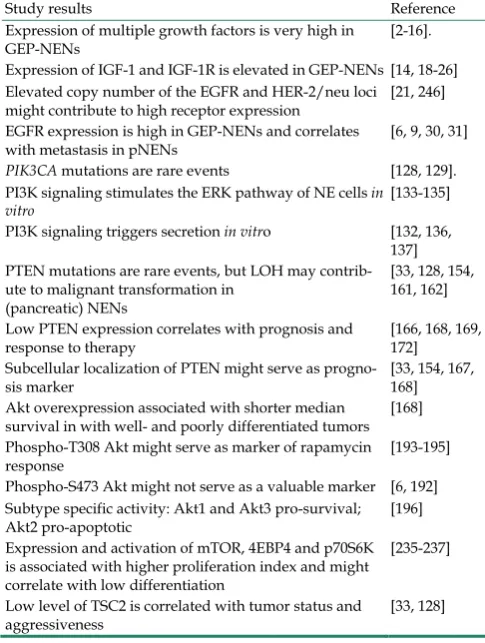T
T
h
h
e
e
r
r
a
a
n
n
o
o
s
s
t
t
i
i
c
c
s
s
2014; 4(4):336-365. doi: 10.7150/thno.7851
Review
PI3K-AKT-mTOR-Signaling and beyond: the Complex
Network in Gastroenteropancreatic Neuroendocrine
Neoplasms
Franziska Briest
1,2
, Patricia Grabowski
1,3
1.
Medizinische Klinik 1 CBF, Dept. of Gastroenterology, Infectious Diseases, Rheumatology CC13, Charité Berlin, Germany;
2.
Freie Universität Berlin, Institute for Chemistry and Biochemistry, Berlin, Germany;
3.
Department of Hematology and Internal Oncology and Center for Neuroendocrine Tumours Bad Berka – ENETS Center of Excellence,
Zentralklinik Bad Berka, Germany.
Corresponding author: Franziska Briest, Phone: +49 30 8445 4579 e-mail: franziska.briest@charite.de.
© Ivyspring International Publisher. This is an open-access article distributed under the terms of the Creative Commons License (http://creativecommons.org/
licenses/by-nc-nd/3.0/). Reproduction is permitted for personal, noncommercial use, provided that the article is in whole, unmodified, and properly cited.
Received: 2013.10.09; Accepted: 2013.12.16; Published: 2014.01.29
Abstract
Gastroenteropancreatic neuroendocrine neoplasms are heterogeneous in their clinical behavior
and require therapies specially tailored according to staging, grading, origin and expression of
peptide receptors. Despite extensive scientific efforts, the therapy options are still not satisfactory.
The main reasons are due to the lack of a broad mechanistic knowledge, an insufficient
classifica-tion of specific diagnostic sub-groups, and predictive markers. GEP-NEN tumors evade early
di-agnosis because of slow asymptomatic growth behavior and are frequently not detected until
metastasized. How signaling networks contribute to tumor progression and how these networks
interact remains unclear in large parts. In this review we summarize the knowledge on the growth
factor responsive non-angiogenetic pathways in sporadic GEP-NENs, highlight promising
mecha-nistic research approaches, and describe important therapy targets.
Key words: Gastroenteropancreatic neuroendocrine neoplasms, signal transduction, growth
fac-tors, kinases, biotherapy, molecular biology, inhibitor.
Introduction
GEP-NENs (Gastroenteropancreatic
crine neoplasms) emerge from various
neuroendo-crine cells of the gastroenteropancreatic system and
represent the largest subgroup of neuroendocrine
neoplasms. This heterogenic entity of solid tumors,
formerly termed GEP-NETs or GEP-NECs
(gastroen-teropancreatic neuroendocrine tumors and
carcino-mas) or “carcinoids”, displays a broad spectrum of
characteristics concerning behavior during growth
and differentiation, functional aspects, localization
and prognosis.
Although they are ranked among rare neoplastic
diseases in general, their incidence has increased
ex-ponentially throughout the last decade. Currently,
GEP-NENs state the second most common
gastroin-testinal malignancy after colorectal cancer [1].
The majority of GEP-NENs is characterized by
slow proliferating, well differentiated G1 phenotypes
(WHO/ENETS classification 2010, refer to table 1),
which are often diagnosed late in the developmental
course by the occurrence of metastases (NEN G1,
previously termed WDNET: well differentiated
neu-roendocrine tumor). In contrast, a small G3 subgroup
of rapidly growing and poorly differentiated
GEP-NENs display a behavior that is comparable to
those of prevalent solid carcinoma entities (NEN G3
or NEC, previously called PDNEC: poorly
differenti-ated neuroendocrine carcinoma). The third group,
characterized by an intermediate malignancy or
un-clear behavior, NEN G2, approximates the former
Ivyspring







